April 28, 2017
Air Date: April 28, 2017
FULL SHOW
SEGMENTS
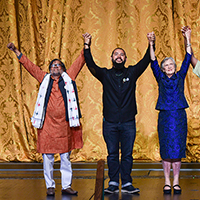
The Goldman Winners 2017
View the page for this story
They call the award the Green Nobel; each year, the Goldman Environmental Prize celebrates the achievements of grassroots activists from each major continent. Living on Earth Host Steve Curwood speaks with two of the six 2017 winners, mark! Lopez who took on pollution from a lead smelter in East Los Angeles, and 83 year old grandmother Wendy Bowman who fights strip coal mining destruction in her native Australia. (13:00)
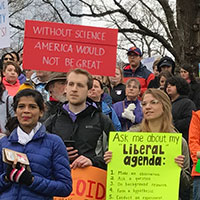
Marching for Science
/ Jenni DoeringView the page for this story
Hundreds of thousands worldwide turned out for the more than 600 Marches for Science on Earth Day. The signs, chants, and songs at these events expressed frustration over proposed US federal funding cuts for research, and celebrated the fruits of science. Living on Earth's Jenni Doering reports from the Boston March for Science. (07:15)
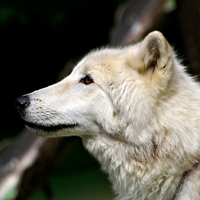
Alaskan Bears and Wolves Under Gun
View the page for this story
Republicans in Congress spearheaded by Alaska Congressman Don Young, a keen hunter, have repealed Obama-era restrictions on hunting predators in National Wildlife Refuges in Alaska. Host Steve Curwood discusses how this will affect wolves and bears with Alaska Dispatch News reporter Erica Martinson. (07:25)
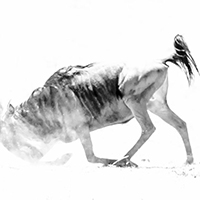
Wildebeest Jousting
/ Mark Seth LenderView the page for this story
Kenya’s vast Maasai Mara Reserve is home to large herds of wildebeest and sometimes even among the mass of the herd, individuals can distinguish themselves with a good old-fashioned brawl. Living on Earth’s Resident Explorer Mark Seth Lender shares his blow-by-blow account of a fierce battle between two males. (02:30)
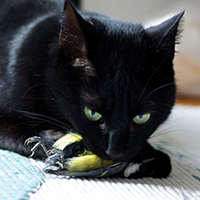
Comments from Listeners
View the page for this story
We take note of some recent thoughts from attentive listeners. (01:35)
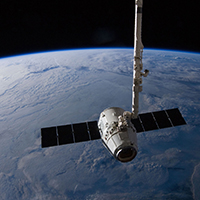
The Traveler’s Guide to Space
View the page for this story
Humanity’s adventure in space is more than half a century old, and soon anyone with enough money may take a trip beyond the atmosphere. They’ll need a guide book and now there is one that supplies both tourists and scientists with a field manual. Called “The Traveler’s Guide to Space: For One-Way Settlers and Round-Trip Tourists,” author Neil Comins, a professor of physics and astronomy at the University of Maine, tells host Steve Curwood that adventurous travellers will experience wonders as well as considerable discomfort and danger. (15:15)
Show Credits and Funders
Show Transcript
HOST: Steve Curwood
GUESTS: mark! Lopez, Wendy Bowman, Erica Martinson, Mark Seth Lender, Neil Comins
REPORTERS: Jenni Doering
[THEME]
CURWOOD: From Public Radio International, this is Living on Earth.
[THEME]
CURWOOD: I'm Steve Curwood. Celebrating the winners of the Goldman Prize, heroes who defend their communities against toxic pollution like lead from a smelter…
LOPEZ: There is absolutely no level of lead that is safe, especially in children, and so it affects brain development. It also affects impulse control and so exposure to lead has been correlated with rates of violence and crime in communities and so we have to ask the question so what role has Exide played in this.
CURWOOD: Also, science defenders rally and take a stand against federal funding cuts…
CHURCH: Why is it that some countries, like China, 89 to 90 percent of elected officials have degrees in science and technology? But in the United States this number is one percent. [BOOS] All of you nerds, start running for office! [CHEERS]
CURWOOD: Those stories and more, this week on Living on Earth. Stick around.
[NEWSBREAK MUSIC: Boards Of Canada “Zoetrope” from “In A Beautiful Place Out In The Country” (Warp Records 2000)]
[THEME]
The Goldman Winners 2017
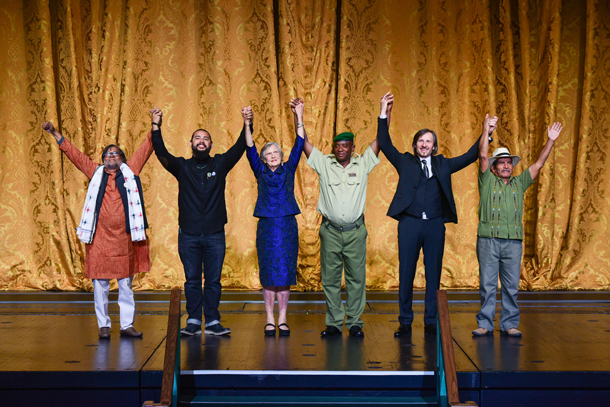
All six Goldman Environmental Prize winners onstage at the 2017 ceremony. (Photo: Goldman Environmental Prize)
CURWOOD: From PRI, and the Jennifer and Ted Stanley Studios at the University of Massachusetts Boston, this is Living on Earth. I’m Steve Curwood. Around the globe people are putting their lives on the line to protect the environment, and the Goldman Environmental Prize honors an activist from each of the six inhabited continents. Some recipients have paid the ultimate price for their work. 2015 winner Berta Caceres of Honduras and Mexico’s Isidro Baldenegro Lopez, who won in 2005, were both murdered last year.
The winners this year are no less courageous. Prafula Samantara of India, Rodrigue Ketembe, a park ranger from Congo, and Rodrigo Tot, a native Q’eqchi from Guatemala all halted mines in their tracks, while Slovenian Farmer Uros Macerl derailed plans for a toxic waste incinerator—all in the face of ferocious opposition. In a few minutes, we’ll hear from 83-year-old Wendy Bowman who battled coal strip mining in Australia. But first we turn to 32-year-old mark! Lopez who fought an Exide smelter in East Los Angeles. mark!, welcome to Living on Earth.
LOPEZ: Thank you. Thank you for having me.
CURWOOD: So, tell me. Who in your community alerted you to the Exide Corporation battery acid recycling plant pollution, and when did you decide to do something about this?
LOPEZ: Yeah, you know, it was actually my grandmother who alerted me. After I graduated from UC Santa Cruz, I went to visit her and my grandpa and she actually handed me a public notice about Exide and was like, "Hey, you know Exide's still there, right?" and she was asking if I know it's still there because her and my mother actually toured the Exide site in the 90s, and you know of course, Exide was telling them all there's nothing to worry about, you know, it's nothing to worry about. So, my grandma said, "Well, if there's nothing to worry about then why did the Cal EPA staff put on all this protective gear and why did they make me put on this protective gear if there's nothing to worry about, and then more importantly, why aren't any of the workers putting on protective gear?" I think that was a signal that if the company is putting their own workers at risk, then they have no problem compromising the health of our communities. So, when I came back from Santa Cruz, she handed me that notice and said, you know, "Get on it."
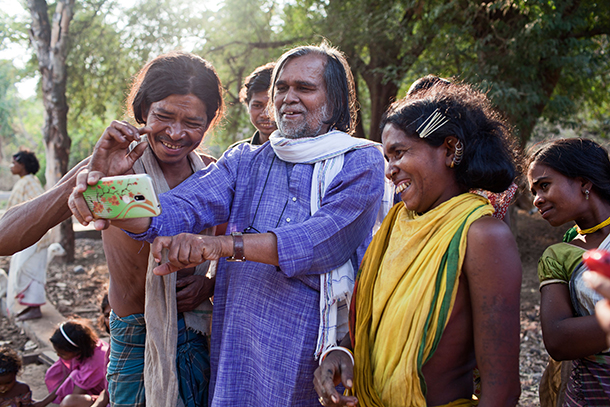
Prafulla Samantara of India was awarded the 2017 Goldman Prize for combatting mining on indigenous land. (Photo: Goldman Environmental Prize)
CURWOOD: So, mark!, tell me. What's the scale of lead contamination that's a problem in LA?
LOPEZ: Yeah, so Exide spewed about seven million pounds of lead into the air, and we're talking about over 100,000 people impacted in east LA and southeast LA. And so, there's absolutely no level of lead that is safe in our bodies, especially in children, and so it affects brain development which impacts educational attainment which of course impacts the future of our communities, but it also affects impulse control, and so exposure to lead in communities has been correlated with rates of violence and crime in communities, and so these are things our communities have been plagued with, and so we have to ask the question:“What role has Exide played in this?”
CURWOOD: Now, what did you and your community find especially challenging in dealing with this type of contamination there?
LOPEZ: One of the hardest parts was actually dealing with the state. The state allowed Exide to operate without a permit for years, and so they're a responsible party in this disaster, right, and so every step of the way they've stalled, they've told us that things couldn't happen or what we wanted was not possible. They told us that the problem was not that big, it's just these two homes we need to clean, and we had to push them to 40 homes, then 80 homes, and 209 homes and now we're over 10,000 homes that the state is acknowledging are impacted by Exide. And that's not even the half of it. They're only looking at 1.7 miles radius around the Exide site, but state Department of Health data was released that showed that up to 4.5 mile radius around the site, there's a higher level of lead in children's blood than the rest of LA County.
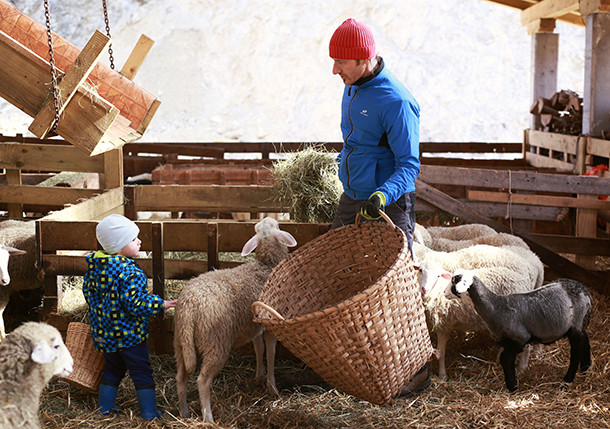
Slovenian Uroš Macerl took over his family farm and embarked on a five-year struggle to reverse decades of air pollution that had impacted the town’s wildlife, domesticated animals, and people. (Photo: Goldman Environmental Prize)
CURWOOD: Now, California's famous for, or I guess some would say, infamous, for being environmentally proactive, but it sounds like your experience is the opposite, that you’ve had to drag the California government kicking and screaming to deal with the lead smelter problem in East LA. Why do you think that is?
LOPEZ: Yeah, you know, I think the state likes to posture itself as somehow different from the rest of the country, of course, with Trump in office now as leading the resistance to the Trump agenda, but the reality is when you think about environmental racism, it exists in East LA and it exists in all parts of LA. It exists in San Diego and Coachella Valley, it exists in the central coast and in the Central Valley in the Bay Area. Environmental racism exists.
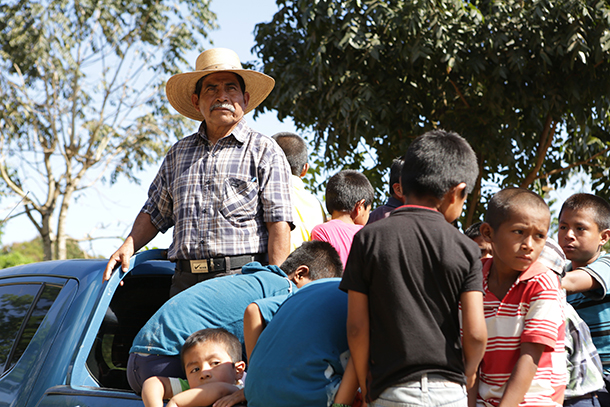
Guatemalan Q’eqchi’ leader Rodrigo Tot worked for more than 30 years to secure land titles for Q’eqchi territories. His efforts have indefinitely deferred nickel mining in two villages. (Photo: Goldman Environmental Prize)
CURWOOD: Tell me about the lead acid battery recycling act of last year, 2016, and the income and fees that it's expected to produce.
LOPEZ: Yes, I think you're referring to Assemblywoman Christina Garcia's bill AB 2153 that is a battery fee bill, and so this fee that's being charged for batteries that actually just started this month will be collected and will create a revenue stream that's estimated at $30 to $40 million a year to help clean up this Exide issue and also 14 other sites across the state of California where they are dealing with lead smelter issues. And they call these ghost smelters because the company no longer exists, and so there is no responsible party, and so this bill is really helping to kind of relieve these issues in communities where there's no other solution in sight.
CURWOOD: So, when you came back from college and worked to close that lead battery smelter, that recycling plant, it sounds like that was just the beginning.
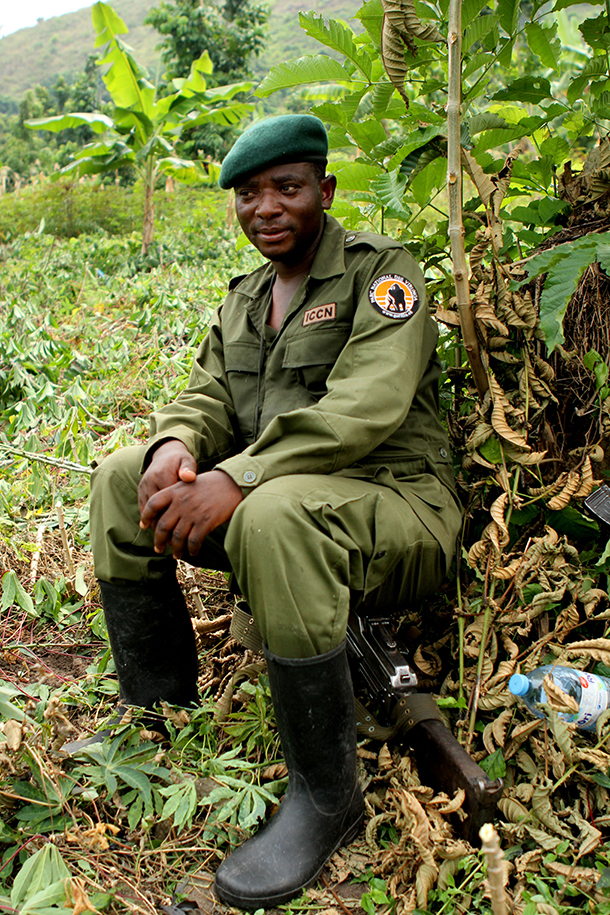
Rodrigue Katembo is a ranger at Virunga National Park and the Goldman Prize winner from Africa. (Photo: Goldman Environmental Prize)
LOPEZ: Yeah, I mean it's interesting, right, because it took something like two decades to shut down the facility, and I think something that's important to note is that I'm third generation in my family fighting against Exide, but all of the work that our community has put in has made it so that my babies aren't the fourth generation having to fight against Exide, right, and that's really significant.
CURWOOD: How do you think the rest of America is responding to the lead contamination crisis?
LOPEZ: I'm really hoping that this Exide issue and the Goldman award is helping to raise the visibility around lead as a crisis that's facing the country. This doesn't happen with a million people marching in DC or even a million people marching in downtown LA. It starts with neighbors talking to each other, saying,“Hey, this is messed up right? You agree too? Let's talk to our other neighbor... it's messed up right?... OK you agree?”... OK you got a couple neighbors on that block, then you can advance on the next block... and you got that block, and you got a neighborhood, and you got that neighborhood and you can get a couple of neighborhoods and start a movement, right? I think our fundamental questions that we try to answer are: what is it, how does it affect us, and what can we do about it? And if you got answers to those questions, then you can start a movement in any community.
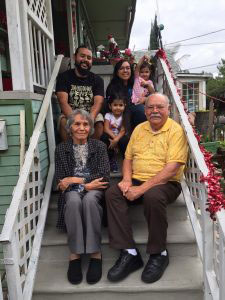
Lopez is the third generation in a family of activists. His grandparents (front) are well-known community-activists in East Los Angeles. (Photo: Goldman Environmental Prize)
CURWOOD: mark! Lopez is one of the 2017 Goldman Environmental Prize recipients. Congratulations, again, mark!.
LOPEZ: Thank you, Steve. It was a pleasure talking to you.
CURWOOD: Joining us now is Wendy Bowman of Australia. Coal mining in Australia goes back 150 years or so, but when strip mining began near her farm in New South Wales, environmental and health concerns turned Wendy Bowman into an activist.
BOWMAN: It was all underground mining, very small in the early days. There didn't appear to be any big problems for a good 150 years, then all of a sudden in about the early-to-mid 1980s, open cut mining started, and the government was letting out -- just putting leases all over the place, and people were getting shocked that their country was in a lease area, and that was the start of all the problems because the mining people were very abusive and argumentative and they told you exactly what we had to do, and so we decided that it was our land, and we would tell them what they could do.
CURWOOD: So, when and why did you found MineWatch NSW, I guess that stands for New South Wales. What's the mission?
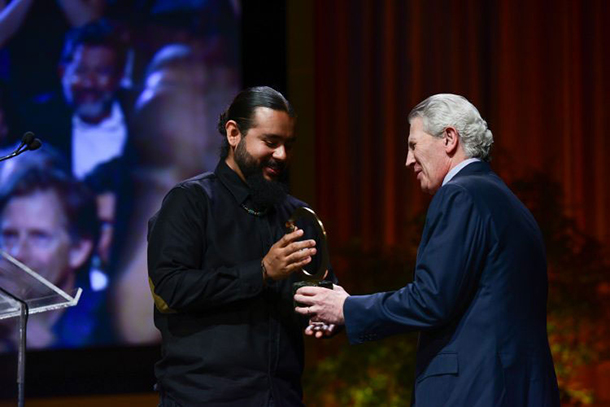
North American winner mark! Lopez accepting his Goldman Prize at the ceremony. (Photo: Goldman Environmental Prize)
BOWMAN: Well, what we did with MineWatch in the beginning, because nobody knew their rights or whatever, we started this group and we found a lawyer and a valuer who both knew New South Wales Coalmining Act very well, so they were able to come to our meetings, explain to everybody what their rights were. So, we helped people doing all this. I mean, there were a lot of small farmers that did not understand these great big environmental impacts statements that the mines would dump at their house and say, "Read that". It was about three encyclopedias big, and so many of them used to ring me up and say, "My God, I can't read all of this," and I would say to them, "Just look at the chapters. You read the chapters that are worrying you, such as noise, dust, water, whatever," and that was basically what MineWatch did to help people.
CURWOOD: So, what kinds of contamination has resulted from the mining?
BOWMAN: Well, the water. That is one of the big problems, and we've only very recently discovered that the contamination is a lot worse than we thought. Now, we've only just discovered that about 40 or 50 kilometers or miles away from Newcastle, the silt at the bottom of the Hunter River is jet black. Now, we have not had time to get it tested, but we believe that is a result of the water slowing down and everything being left and that is the latest big worry, but prior to that, all our creeks in the rivers, the water was so clean and beautiful. You could see all the rocks in the bottom of the water. You could see the fish, the turtles, and we had platypus in all the rivers. There's none left.
CURWOOD: The platypus is gone, huh?
BOWMAN: Anywhere where there's been mining, mine water being allowed to go down the river or the creek, there's no more platypus.
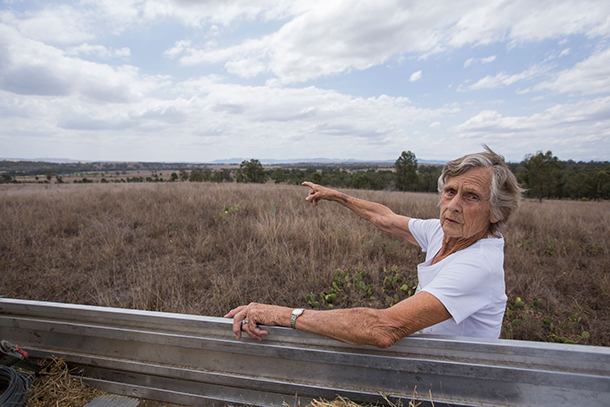
Wendy Bowman is one of the last residents left in Camberwell, a small village that bore the brunt of coal mining pollution in New South Wales. (Photo: Goldman Environmental Prize)
CURWOOD: What kind of pollution-related health impacts are you seeing among people who are near these mining operations?
BOWMAN: For years, the blasting at the mines was so big that we had this orange cloud so thick you could hardly see your own back gate, and that covered all your roof, it covered everything, and we found when we owned the farm next door to this open cut mine that all that dust landed on the crops that the dairy cows had to eat. They would walk in after a blast and walk back out again, they would not eat it, and so this was the big problem, the dust. And so, nowadays, we have worked with the New South Wales Mineral Council, the blasts have gone right down to what they used to be. They're not allowed to blast if there is a wind blowing, etcetera, etcetera. They have to be very careful. Then we started – in Singleton we started the Singletonshire Healthy Environment Group because we heard that so many people had respiratory problems like asthma and that sort of thing, and when you see lots of little children coughing and spluttering... I know young teenagers that are so bad with their asthma that they have oxygen at home, but sometimes that's not enough, so their mother's got to race them -- it takes a half an hour to drive into town to the hospital where they've got the bigger oxygen things and they can stay there overnight.
CURWOOD: Talk to me about how you'll continue to oppose the negative and environmental health impacts of coal mining in Australia. What's next?
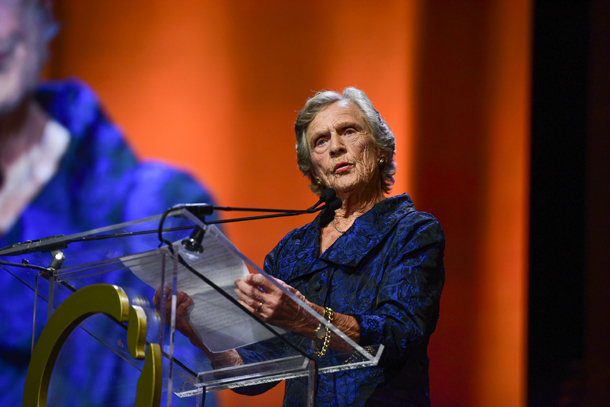
Bowman giving her acceptance speech. (Photo: Goldman Environmental Prize)
BOWMAN: Well, we haven't gotten very far with the health problems just recently. The government just doesn't want to seem to know anything about it. For years now, we have been asking... every time there's a new mine or an extension to a mine, we have said there must be a health assessment added to the environmental impact statement, and the government will not do it. And we've been asking this, I'd say, for at least 15 or 16 years. They won't do it. So, I think the more people like us say something, they're going to have to start thinking about it.
CURWOOD: Wendy Bowman is a Goldman Prize recipient and founder of MineWatch New South Wales. Thank you so much for taking the time today, and congratulations!
BOWMAN: Thank you. It's been a pleasure speaking to you.
Related links:
- Goldman Prize website
- More on Wendy Bowman
- More on mark! Lopez
- The Full Goldman Prize Ceremony
[MUSIC: Keola Beamer, “Keiki Dream (Child’s Dream)” on Mauna Kea – White Mountain Journal, Dancing Cat Records]
CURWOOD: Coming up... Republicans grant Alaskans the right to hunt bears and wolves even in the Arctic National Wildlife Refuge. Stay tuned to Living on Earth.
ANNOUNCER: Support for Living on Earth comes from the Gordon and Betty Moore Foundation, and from a friend of Sailors for the Sea, working with boaters to restore ocean health.
[CUTAWAY MUSIC: Keola Beamer, “Keiki Dream (Child’s Dream)” on Mauna Kea – White Mountain Journal, Dancing Cat Records]
Marching for Science
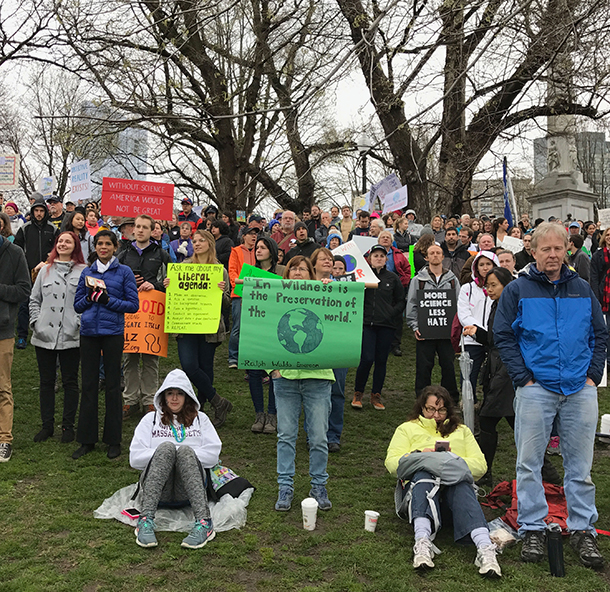
Organizers estimated that 50,000 people turned out for the Boston March for Science (Photo: Jenni Doering)
CURWOOD: It’s Living on Earth, I’m Steve Curwood. On Earth Day, April 22, hundreds of thousands turned out for as many as 600 marches worldwide to speak out for the sciences. And many of those who participated in the US were protesting what they see as the “anti-science” agenda of the Trump administration. With about 50 colleges and universities in the greater Boston area as well as a bevy of high-tech medical and bioengineering firms, the region is a hub of scientific research and tech companies. So as thousands gathered in Washington, New York, Los Angeles, and San Franscisco, thousands more gathered on Boston Common despite a cold and drizzly day. They carried home-made and often witty signs that touched on climate change, research funding, and how much our society owes to science. Living on Earth’s Jenni Doering was there and has our story.
PETRA: Hey! Hey! Ho! Ho! No one misses polio. Hey Hey! Ho Ho! No one misses polio.
DOERING: In case you didn’t quite catch that...
PETRA: Hey! Hey! Ho! Ho! No one misses polio.
DOERING: Petra, who’s about 4, shouted into a megaphone on Boston Common, beside her mother Katie.
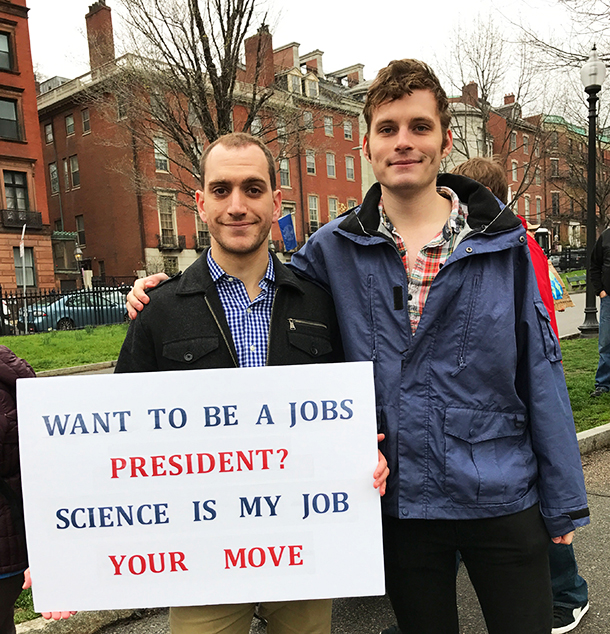
Nathan Smith, left, was there with his cousin, Joseph Marcus. (Photo: Jenni Doering)
KATIE: I am an infectious disease physician and I take care of HIV patients. So my sign says, “Got polio, smallpox, measles, diphtheria, tetanus, plague, ebola, yellow fever? – No? You’re welcome, Science.”
DOERING: Some 50,000 people braved a persistent cold rain at Boston’s March for Science. Some wore white lab coats; many carried clever signs like “Only primatologists should monkey around with science!”, and in a proud display of nerd culture, a few spelled out words using symbols from the Periodic Table. On this 47th Earth Day, former EPA Administrator Gina McCarthy kicked off the speeches at the main stage.
MCCARTHY: My poor EPA! I love you! [CHEERS] Every aspect of EPA’s work seems to be under attack, including the expertise of that wonderful career staff who have worked so hard to successfully deliver on our promise of clean air, and clean water and land. Career staff who have helped us take strong, sure steps to combat climate change. Staff who are now facing a presidential budget that seeks to cut the agency staff by a third and its science in half. We cannot tolerate that! [BOOS]
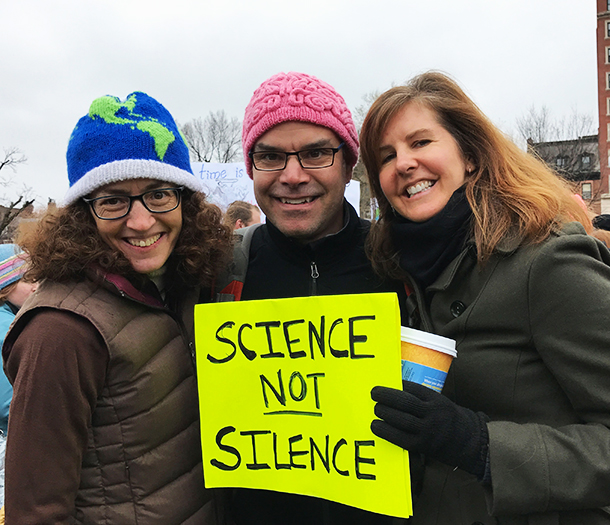
Immunologist Seth Brooks, center, was accompanied by Kelly Kieffer (left) -- who knitted the earth and brain hats -- and Stephanie Klees, both of whom are physicians. (Photo: Jenni Doering)
DOERING: Physicians, bioengineers, tech entrepreneurs, even a rocket scientist took the stage. About half the speakers were racial minorities, but the crowd was overwhelmingly white. And although the organizers aimed to avoid being partisan, walking through the crowd there were signs denouncing President Trump’s proposals to cut research funding everywhere, from the NIH to the EPA. “Resist the anti-science agenda;” read one, and, “Want to be a jobs president? Science is my job. Your move.” Immunology professor Seth Brooks, under a pink beanie knitted to look like a brain, spoke about the economic costs of gutting research.
SETH: From a basic economic standpoint, science funding from the federal government generates somewhere between 2 and 8 dollars of economic activity for every dollar that’s spent. And that return on investment is huge.
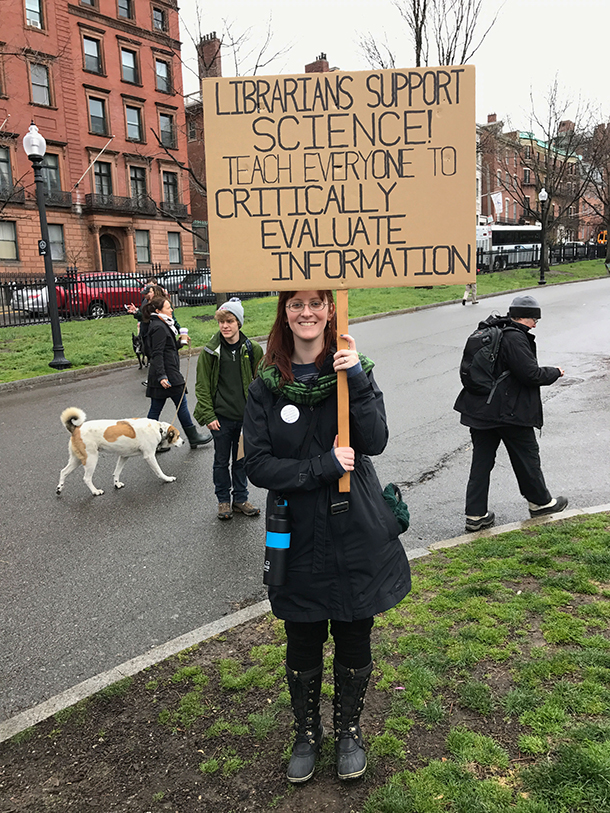
At least 30 librarians came to the march to draw attention to the importance of information literacy, including Margaret Rosequist, above. (Photo: Jenni Doering)
DOERING: A group of some 30 librarians, shocked by the proposal to eliminate all federal funding for the Institute of Museums and Library Services, marched to the Common from Boston Public Library.
LIBRARIAN: As a librarian I’ve been thinking a lot about information literacy, which is the skill of critically evaluating information. And librarians have been very concerned with things like government sources no longer being as reliable as we might hope that they would be.
DOERING: Another Seth – in his Red Sox hat - said he’s not a scientist, but he had to take a stand.
SETH: I’m here in particular reaction to the degradation of climate change and to appointing people who fundamentally don’t believe in it to government; and the general war on intellectualism and sort of warping of science into a political tool.
AVERY: That’s all not good stuff.
DOERING: His son Avery, a freckled redhead who couldn’t have been older than ten, also had a sign.
AVERY: Um, it says: ‘The good thing about science is that it’s true whether or not you believe in it,’ which is a quote from Neil deGrasse Tyson.
DOERING: One might guess that Neil deGrasse Tyson, the astrophysicist and science populist, would have been glad to see the science-based kids’ activities at the event.
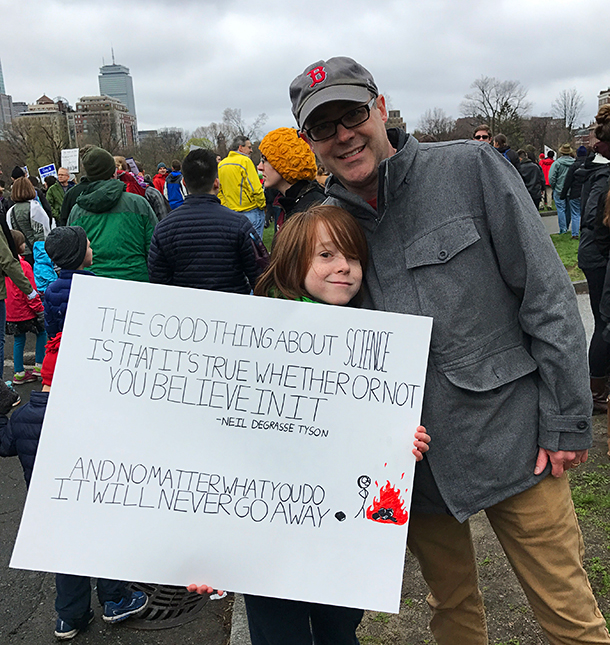
Avery and his dad Seth. (Photo: Jenni Doering)
ACTIVITY GUY: Take this grape. You’re gonna get one piece of paper, and you can use up to 10 toothpicks, and you’re gonna work on a solution to protect the grape from getting smushed by the grape crusher.
DOERING: The crusher? A simple wood contraption – like a hammer with eyes painted on.
ACTIVITY GUY: This guy, his name is Julius Squeezer. What’s gonna happen is, we’re gonna drop it on one, two, three – [BAM!] – we’re gonna try and smush your grape.
DOERING: Engaging kids in engineering challenges is easy enough...
KID: I want to do it! I want to do it!]
DOERING: ... but science has failed to engineer diversity within its ranks. Chiderah Okoye is the President of the Boston chapter of the National Society of Black Engineers.
OKOYE: I want us to start envisioning an internal threat we have in science and technology – and that’s one that’s marked by stark underrepresentation of select ethnic groups. [CHEERING]
DOERING: Speakers shared stories of the ethnic prejudice some scientists face. Physics and engineering teacher Graciela Mohamedi recalled when, while completing her postdoc at Boston University, she stepped outside her lab to call her Spanish-speaking grandmother. An older man came up to her.
MOHAMEDI: And he told me to get off the phone, to go clean the bathroom, because it hadn’t been done properly. [CROWD BOOS] That man saw my dark hair. He saw my dark eyes and he saw my olive skin. He heard my mother’s language on my lips and in that moment he decided that I could not be a scientist. [BOOS]
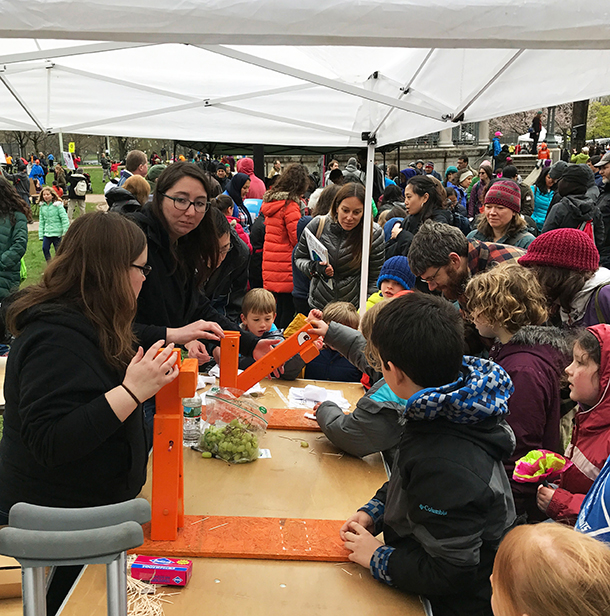
Activity tables like this Massachusetts Destination Imagination engineering challenge, featuring the grape-crusher “Julius Squeezer”, attracted kids and families. (Photo: Jenni Doering)
DOERING: In the crowd, a woman wearing a Muslim headscarf carried a sign that said, “This is what a scientist looks like.”
MOHAMEDI: If we want our children to truly believe that when they grow up they can be anything that they want to be, then the inherent racial and sexist prejudices within the sciences must. Be. Shattered! [CHEERING]
DOERING: And leading Harvard geneticist George Church urged the crowd to shatter another barrier.
CHURCH: Why is it in some countries, like China, 89 to 90 percent of elected officials have degrees in science and technology? Maybe that’s a bit too much, but in the United States this number is one percent. [BOOS] All of you nerds, start running for office! [CHEERS]
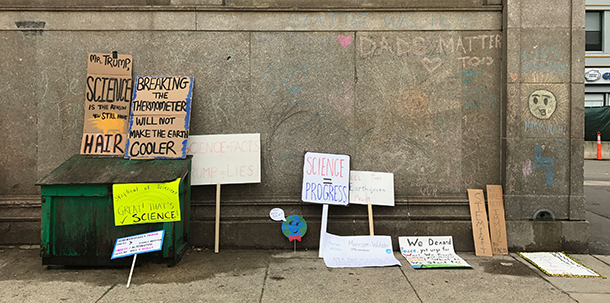
Signs left near the Park Street T station after the event (Photo: Jenni Doering)
DOERING: George Church. [FADE IN CROWD SINGING “THIS LAND IS YOUR LAND”] And despite the cold and soggy weather, plans were underway for another demonstration of people power - a climate march the following weekend on April 29.
[CROWD SINGING: “Join the resistance! Science is good for you and me!”]
DOERING: For Living on Earth, I’m Jenni Doering.
[MUSIC CONTINUES]
Related links:
- March for Science Boston
- The Atlantic: “All the Ways Trump’s Budget Cuts Science Funding”
- President Trump’s “America First: A Budget Blueprint to Make America Great Again”
- LOE: Some scientists decided to opt out of the March for Science
- LOE: Marching for the Earth and Science
- Boston People’s Climate Mobilization is organizing the march on April 29th
Alaskan Bears and Wolves Under Gun
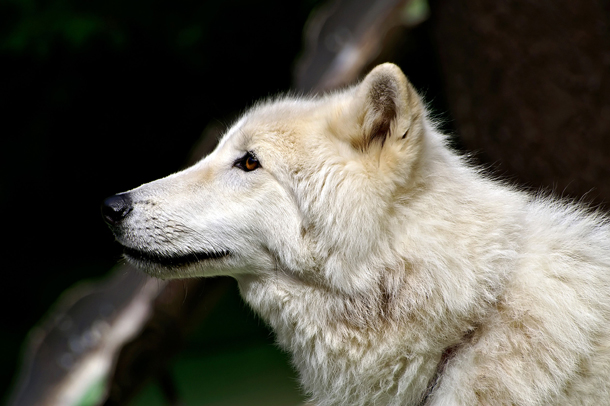
Among the wildlife in Alaska affected by the repeal of the Wildlife Refuges Rule are wolves, which can be hunted under certain circumstances. (Photo: Michael Krish, Flickr CC BY-SA 2.0)
CURWOOD: One of the Obama administration rules that Republicans have repealed using the Congressional Review Act imposed restrictions on the hunting of predators, including bears and wolves in National Wildlife Refuges in Alaska. Restrictions still remain in national parks, but now Alaska rules govern predator hunting in the refuges, rules that are designed to help hunters by reducing the number of predators that take game such as deer, moose and caribou. Tensions are high on both sides of this issue, and the Center for Biological Diversity is challenging the legality of the repeal, saying that the law requires regulation of refuges benefit nature, not hunters. The repeal effort was led by Alaska Republican Congressman Don Young, himself an avid hunter. Erica Martinson is an Alaska Dispatch News reporter in Washington DC, and she joins us now. Welcome, Erica.
MARTINSON: Hi. Thanks for having me.
CURWOOD: So, first of all tell me what is this Wildlife Refuges Rule, and what does it do or rather what did it do?
MARTINSON: Well, it gave the Fish and Wildlife Service ultimate control over hunting regulations on refuges and near refuges and what reason they are allowing and when they allow hunting of bears and wolves.
CURWOOD: Now, how come Alaskans are so upset by this rule that they filed a bill to get it repealed and got it repealed?
MARTINSON: Well, on some level for many, it's an argument over state's rights over who gets to be in charge. On others’, it's about something they call predator control, the Board of Game in Alaska wants to allow at certain times the hunting of wolves and bears in order to keep the populations of moose, deer and caribou up so that people who want those animals will have animals for meat. The federal government isn't in favor of that, isn't in favor of bolstering populations for hunting reasons.
CURWOOD: So, supporters of the federal rule said that it stopped the killing of wolves and pups in the their dens, the killing of bears from aircraft and shooting at grizzlies at baiting stations. How accurate is that picture, and to what extent would the repeal cause an increase in these activities at all?
MARTINSON: It's hard to tell. There's a lot of hyperbole on both sides on this, but overall there hasn't been much predator control activity on refuges. It's often near, in the near areas, and the shooting from helicopters is pretty rare. There was one instance a few years ago on a certain island that's part of a maritime refuge, but all in all there's about 1,100 wolves are killed every year in Alaska, and about 12 percent of those come from predator control. So, it's going to be a much smaller amount that are affected by this especially since this only impacts refuges, and not state lands.
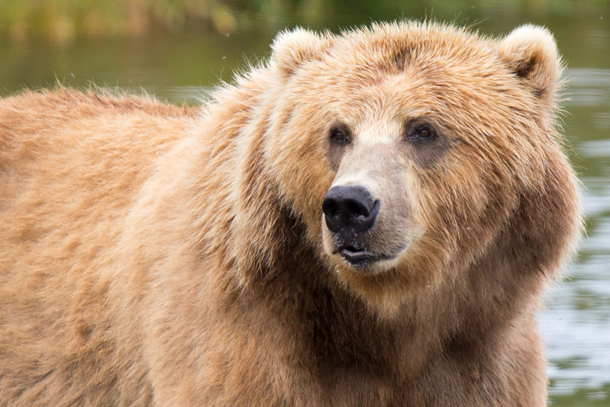
Also at risk of increased hunting is the Kodiak Brown Bear, a key species in Alaska’s Wildlife Refuges. (Photo: Alaska Region U.S Fish and Wildlife Service, Flickr CC BY-SA 2.0)
CURWOOD: What was the scientific basis of the federal regulation?
MARTINSON: Well, it's more statutory basis. The Fish and Wildlife Service argues that their statutes and law requires them to control for the environmental balance and not for predator control. And Alaska state legislation gives the state to control for maximum yield for hunters.
CURWOOD: So, to what extent do Alaskans want local control of Fish and Game regulations turned over to the state, get the feds out of the business.
MARTINSON: I mean, as with everything, it depends on which Alaskans you talk to. I think that there are plenty that were in favor of the federal regulations and plenty that were opposed to it, you know most often these federal Fish and Wildlife regulations were set by federal workers in Alaska, so it's a decades-long history of disagreement over this in the state.
CURWOOD: By the way, no one's ever sued to try to stop the use of the Congressional Review Act. It's been used only a few times. What do the lawyers tell you about the odds of the folks who are suing, the Center for Biological Diversity. What do lawyers say their odds of success might be here and why?
MARTINSON: Well, I think, it's hard to tell. As you said, it's not been used. Actually, the Congressional Review Act has only been used once since it was passed during the Clinton administration. In 2001, George W. Bush signed a resolution overturning an OSHA rule on repetitive stress injuries in workplaces and since then it's never had the alignment of one party having the House and Senate and also the Presidency and having just turned over from another, which is sort of what's required. But since then I think it's 13 CRA resolutions have been signed by President Trump. There's quite a few regulations that have been overturned long-time, and some of these were ones that were issued at the very last minute and most were in the making for years. And I think that there's probably a constitutional question there, and I would think that Center for Biological Diversity is trying to set themselves up for a good option by going through the Ninth Circuit which tends to be more amenable to environmental concerns, but their hope has got to be ultimately that this would move up to the Supreme Court, which could take years; so, we'll have to see.
CURWOOD: So, in this particular rule, the Center for Biological Diversity arguing that this rule was done over many, many years and isn't really just the product of the last 60 legislative days -- I think that's the rule for the Congressional Review Act.
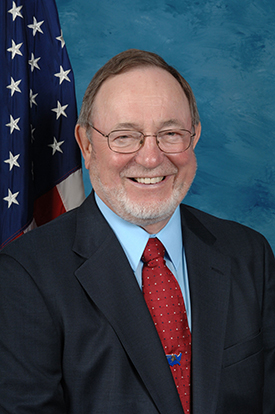
Also at risk of increased hunting is the Kodiak Brown Bear, a key species in Alaska’s Wildlife Refuges. (Photo: Alaska Region U.S Fish and Wildlife Service, Flickr CC BY-SA 2.0)
MARTINSON: It was issued last summer... actually there's a very similar, nearly identical rule issued by the National Park Service for National Parks in Alaska that has not been overturned because it was just issued too far back a year ago. So, it's certainly not something that was done at the last minute or with the intent having overturned, but I think the key to it, what they're arguing is that it's a blunt instrument, the Congressional Review Act. Anytime you overturn something using the Congressional Review Act, nothing substantially similar can never be passed again. It means there's no chance for the Fish and Wildlife Service to tweak this rule or do something similar. It means that they've lost all ability to write any kind of regulation about this.
CURWOOD: By the way, Erica what are some of these refuges in Alaska which will now have this change in rules?
MARTINSON: Well, people might recognize the Arctic National Wildlife Refuge, Izembek National Wildlife Refuge and Kenai National Wildlife Refuge. There's one in Yukon and Kodiak. There are 16 of them. They take up about 77 million acres in Alaska, and about three-quarters of the nation's refuge lands are in Alaska.
CURWOOD: So, if I understand this right, Kodiak is famous for the biggest of all grizzly bears, the Kodiak bear, so this rule change means that perhaps people could go and shoot these bears where they weren't able to do so before, huh?
MARTINSON: Potentially in the future, I mean, the Alaska board of game still has very significant rules for hunting all over Alaska and this doesn't wipe out the existence of hunting rules entirely. People aren't allowed to just hunt whatever with these actions. It just sort of alters the lay of the land for how they decide each year's hunting allotments, who can hunt where and what.
CURWOOD: So how much of a big deal has this been in Alaska? How vociferous has the public debate been on this, and what's the feeling now that it has been resolved this way?
MARTINSON: People are broadly happy to see the state get control over something that they felt was taken away by the federal government. There was certainly broad agreement amongst Alaska's Congressional delegation, not only with Congressman Young, but Senators Murkowski and Sullivan were both very much in favor of this rule, though I do think there are thoughtful Alaskans that disagree and will continue to over time. That's something Alaskans do a lot.
CURWOOD: Erica Martinson is a reporter for the Alaska Dispatch News. Erica, thanks so much for taking time with us today.
MARTINSON: Thanks for having me.
Related links:
- Erica Martinson, Alaska Dispatch News, “Don Young’s wildlife management regulation repeal signed into law”
- Erica Martinson, Alaska Dispatch News, “U.S House passes Don Young’s bill to repeal Alaska wildlife management rule”
- Center for Biological Diversity press release on the lawsuit
[MUSIC: Jacqueline Schwab, “Glen Of Thickets” on Mad Robin-Reflections On English Country Dances, 18th century Scottish-Gaelic air published by Capt. Simon Fraser, Midsummer Records]
Wildebeest Jousting
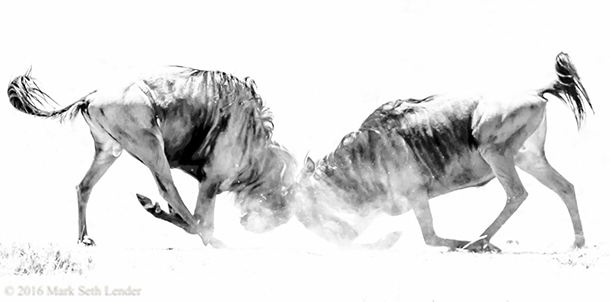
Wildebeest at battle (Photo: Mark Seth Lender)
CURWOOD: Wildlife in Africa is often well-protected, with vast areas like the Maasai Mara Reserve in Kenya, where tourists marvel at lions and leopards, and the great annual migration of zebra, gazelle and wildebeest on the Serengeti. Living on Earth’s Resident Explorer Mark Seth Lender watched a herd of wildebeest – and found that even in the mass of the herd some seem to stand out as individuals.
Valor
Wildebeest Jousting, Maasai Mara
© 2017 Mark Seth Lender
All Rights Reserved
LENDER: Not an hour after sunrise and already, too bright to see. Everything has lost its color. Its shape. Outlines blur, the brilliance obscures (like sprayed white paint). It hurts to look at it. And yet the light contains no heat; it is cooler even than yesterday. The rains are late, again. Maybe the weather will finally change.

A herd of wildebeest, also known as gnu, approaches (Photo: Mark Seth Lender)
But in the waiting grasses the only clouds are dust: Two wildebeest out to bash each other’s brains. Head to head so hard they come down on their knees, hind legs bucking the air, the splintering of their horns. One turns and the blows of the other does the turning. He pushes like a plow. Like Flying Horses in a Merry-Go-Round, only in one direction. If it hurts they do not show it.
They are dumb to the pain, deaf to the breath that is heaving.
They slam together, their tails are banners, their hoofs stammer and the dry ground tears.
It is hard to see what anyone gains.
And around again.
Brought down again.
Sixty kilos shy, the loser is ordained...
At last, the one who had no chance has lost. And the victor does his victory dance all four feet in the air above the field of despond, “Look at me! Over here! Look here!”
And his only want was the winning.
The loser head low walks slow his hooves heavy as stones, and the boss that would have been his crown cracked and broken. There was no chance for him. Absolutely none.
What matters in the end except to strive and not to yield? The Brave is the one who knows that he will lose.
Only Heroes live the Heroic Life.
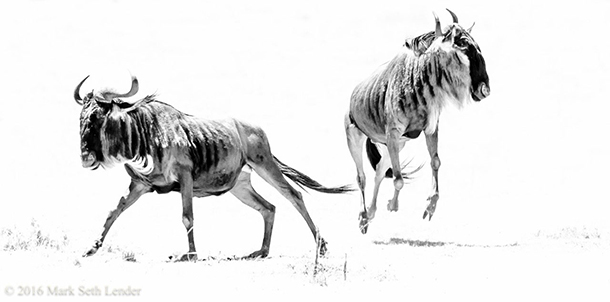
The victor does his dance, all four hooves in the air. (Photo: Mark Seth Lender)
[SOUNDS OF WILDEBEEST GRUNTING]
CURWOOD: Mark recorded these wildebeest grazing, and you’ll find his photos of the pair jousting, at our website, LOE.org.
[WILDEBEEST GRUNTING]
Related links:
- Watch a National Geographic video of wildebeest migration
- Learn more about wildebeest from the African Wildlife Foundation
- Mark Seth Lender’s website
- Donald Young Safaris made Mark Seth Lender's field reporting possible
Coming up... the delights and dangers facing the space tourist, who, by the way, is no longer Living on Earth. Stay tuned.
ANNOUNCER: Funding for Living on Earth comes from you our listeners, and United Technologies - combining passion for science with engineering to create solutions designed for sustainability in the aerospace, food refrigeration and building industries. UTC companies such as Otis, Carrier, Pratt & Whitney and UTC Aerospace Systems are helping to move the world forward.
This is PRI, Public Radio International.
[CUTAWAY MUSIC: Winyo: Benga and Traditional Music From Kenya, traditional Luo song, live at the Library Of Congress’ Homegrown Concert Series, December 2014, not commercially available. (Winyo records on Ketebul Records.)]
Comments from Listeners
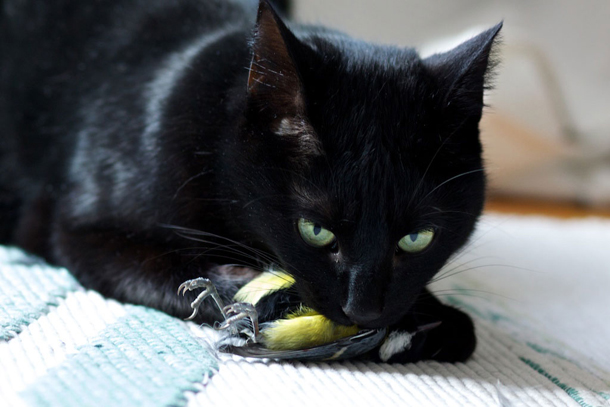
Domestic and feral cats may kill more than 1 billion birds in America each year, according to research from the Smithsonian Conservation Biology Institute. (Photo: Pierre Wolfer, Flickr CC BY-ND 2.0)
CURWOOD: It’s Living on Earth, I’m Steve Curwood.
[LETTERS THEME]
CURWOOD: And now comments from you our listeners…
[LETTERS THEME CONTINUED]
CURWOOD: Some of your thoughts in just moment, but first, a correction. We reported on proposed cuts to federal lead remediation programs last week, but got a figure wrong. Their value is correctly $17 million, not $17 billion. Sorry!
Now, some of you are kind like Jinx Jenkins of Spartanburg, South Carolina.
JENKINS: I never ever miss Living on Earth. Usually, I get up at 6 or 6:30 and my dog at 6:30 says, “Well, I think it’s time to get up”, but I say, “No, it’s Sunday, we’re listening to Living on Earth, and we'll get up at 7”. Thank you!
CURWOOD: Thank you! And Carol Kowalski from Oklahoma called with praise too, but a sting in the tail concerning Sean Powers’ story about the Atlanta Cat Café.
KOWALSKI: Pretty unconscionable story however about the cats. For your penance, you’ll have to say five Hail Marys, five Our Fathers and do a story on the environmental damage that are done by house cats. Stinking, rotten, evil, horrible housecats, to birds and small reptiles, frogs and lizards.
CURWOOD: Rick emailed our comments line with related sentiments. “These invasive predators”, he writes, “are some of the deadliest threats to all kinds of small animals. And their owners who let them out are enablers.” Well, appreciation and criticism, we’re happy to have all comments. Please keep them coming. Email comments@LOE.org. Once again, comments@LOE.org. Or you can call our listener line, at 617-287-4121. That's 617-287-41-21.
[END LETTERS THEME]
Related link:
The Cat Café Piece
The Traveler’s Guide to Space
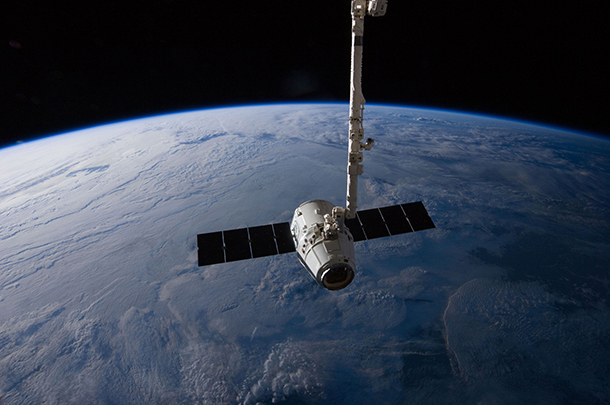
The SpaceX Dragon cargo craft. (Photo: NASA Johnson, Flickr CC BY 2.0)
CURWOOD: Humans have been leaving the planet to travel in space for more than 50 years, but only a handful of people who aren’t scientists or test pilots have had the privilege so far. Well, that’s about to change with Elon Musk’s Space X program. He plans to send space tourists around the moon in 2018, and he’s promised to go eventually to Mars. So if you are thinking a bit about space tourism – say orbiting the Earth or the moon or even taking the big trip to Mars, there is now a book for you. "The Traveler’s Guide to Space: For One-Way Settlers and Round-Trip Tourists" is part Fodor’s guide and part textbook. It gives the reader a well-researched handbook for interplanetary travel, covering aspects of space travel to interest the inexperienced tourist as well as the research scientist. The author, Neil F. Comins, comes by his expertise honestly. He teaches physics and astronomy at the University of Maine at Orono. Welcome to Living on Earth, Professor Comins.
COMINS: Thank you. Pleasure to be here.
CURWOOD: So, what do you think the biggest challenge is going to be for first-time space travelers?
COMINS: Well, it depends on how long they're up there, and then depending on where you go, adjusting to the changes in your body in space, really profound.
CURWOOD: What do you mean changes profound? What kind of things do you go through?
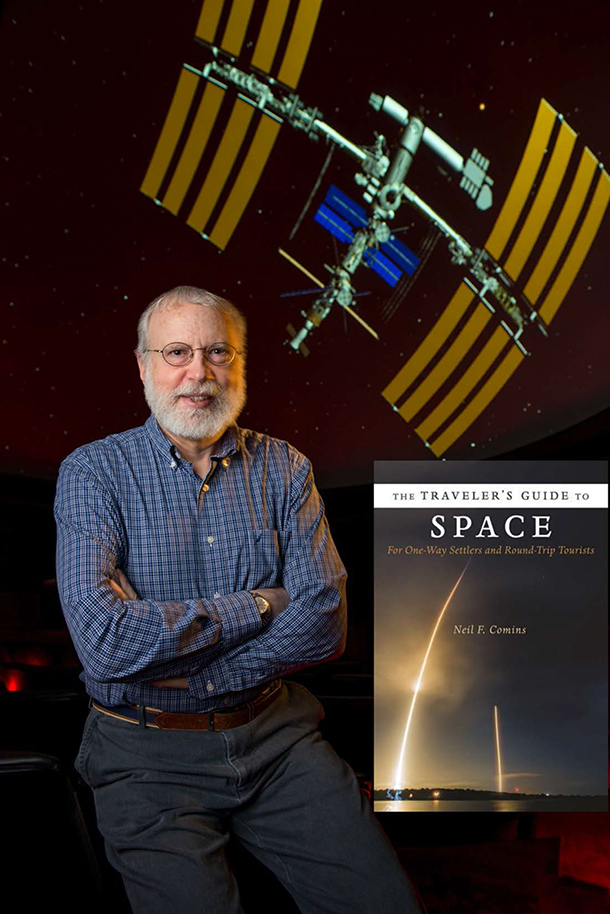
Neil Comins, professor of physics and astronomy at the University of Maine, authored The Traveler’s Guide to Space. (Photo: Neil Comins)
COMINS: Well, for example, [LAUGHS] if you've ever seen the police stop somebody for being intoxicated, they will run them through some tests and one of the tests they do, for example, is to have them stretch their arms out and then put their finger - index finger say - on their nose. And it's something that when we're normally working, living on earth and not drunk, we can do just fine. When you go into space you lose that ability. So, one of the first things you have to do, and you're taught about this before you go, one of the first things that you have to do is to re-coordinate your muscles. So, if you are, for example, going to reach out and press a button, say, the chances are in the normal scheme of things when you first go into space you're either going to mash your finger into the button or miss it entirely because your muscles don't know what to do. So that’s an example of one of the things.
Another thing that happens as soon as you get into space is the fluids in your body start changing, and the reason for that is that, well, you don't need your legs very much anymore, and they don't need the blood supply that they're getting because you're not using them. And so your body literally starts redistributing the fluids inside it, and you physically start changing, your legs get spindly, your face gets puffy, and you have to adjust. It takes several days for your body to adjust, get the fluids where they should be -- mostly out of your body.
CURWOOD: When I get excited about a new destination and go get a guidebook about that place, one of the first things to do is to look at the restaurant and food options, but in your book no such luck. Why is that?
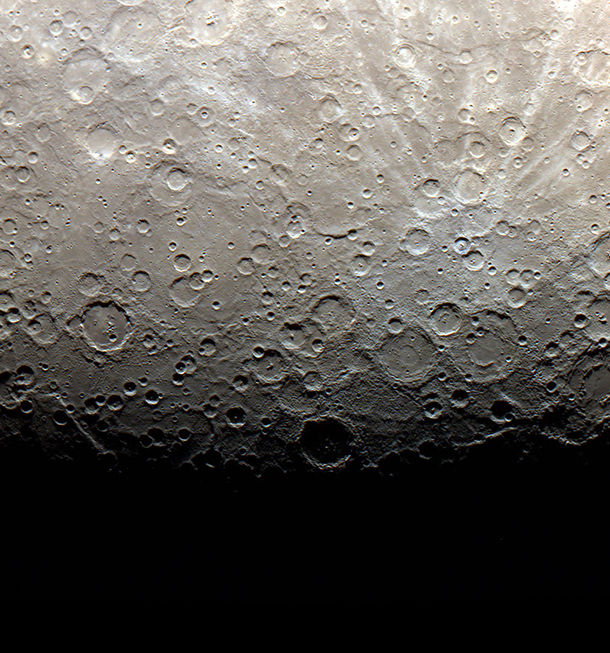
On Mercury, three days are equivalent to two years; in other words, the planet spins around its axis three times for every two orbits around the Sun. (Photo: NASA/Johns Hopkins University Applied Physics Laboratory/Carnegie Institution of Washington, Flickr CC BY 2.0)
COMINS: Well, it's even worse than no such luck. It turns out that when people get into space, our sense of taste diminishes. Things that would be spicy to us here on Earth can be almost tasteless. The best that they can do is provide much spicier foods than you normally would tolerate here on Earth to compensate for that, and if there's good news to go along with this, the art of making food for space has come a long, long way from the days where it was pressed out of tubes, for example. Things are getting better as far as foods are concerned, but as we say in Maine, we ain't there yet.
CURWOOD: Now, if someone is interested in venturing into space, say, they want to write one of those big checks to Elon Musk who’s saying he’s going to take people there, what sort of questions should they ask themselves first?
COMINS: Well, that's an excellent question. There are lots of things: number one, are you willing to put up with the preparation that goes into it, and that can be, depending on who you fly with, and where you're going, that can be up to a few years. For example, the cosmonauts when they prepare they have four to five years worth of preparation. It won't be that long if you're going on a short flight, suborbital flight which means up and back but not into orbit, or to the space station six months or a year perhaps depending on, again, who you're flying with, but it really is a matter of getting your mind wrapped around it, number one. And then there are things like what are you going to do when you're there? And perhaps the most important thing to realize if you're going to space is that when you come back you're going to be a different person.
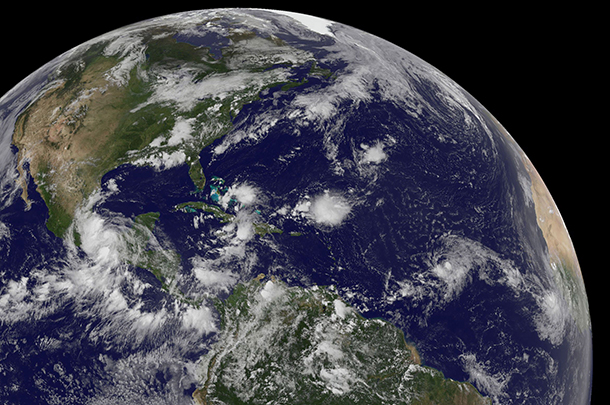
There is a room in the International Space Station (ISS) where one can view a full half of Earth at a time – so in 90 minutes, the time it takes the ISS to orbit the Earth, an observer there would see the entire surface of our planet. (Photo: Rob Gutro / NASA Goddard Space Flight Center, Flickr CC BY 2.0)
CURWOOD: How so?
COMINS: Well, suppose you were to leave your family for, say, six months and go to Europe, and do things that number one, you haven't ever done before, and no one else in your family is doing or has done, and you see the world differently because you’ve been, say, to the mountain tops, and you're coming back home with a perspective about the Earth and your life and your relationship to the Earth that is different than when you left. Adjusting to how you are different when you come back from space compared to your family and friends is incredibly important to understand, and so working to realize that and be ready for that, very important.
CURWOOD: So, talk to me about the joys of traveling in space. What is there to see and do?
COMINS: Oh, lots of wonderful things. Again, it really depends on where you go, but one of the most popular things that all the astronauts I've ever talked to say is to look at the Earth. There is a room on the International Space Station where they can sit and look at the Earth as -- as a whole to see half of the Earth at any given time and watch it. They can sit there for a long time because it takes 90 minutes for the space station to go around the Earth. So, if you sat and watched the Earth from space for 90 minutes, you would see the day side, the night side, and every inch of your surface sailing by over your head, and that apparently gives astronauts great satisfaction.
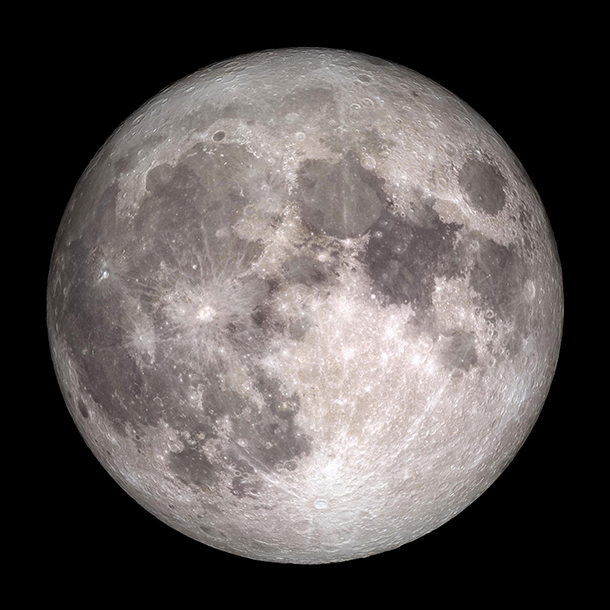
The Moon may soon become a tourist attraction for the travelers who are looking for extraterrestrial experiences. But according to Comins, the Moon needs some basic amenities before you book your flight. (Photo: NASA, Flickr CC BY 2.0)
Another possibility of fun things to do is if you go to another world, say, our moon or the moons of Mars, or space debris like comets or asteroids in our neighborhood, the travelling on those worlds is going to be a spectacular experience. If you go to the moon, by the way, by the time you get there I expect that the places where the Apollo astronauts landed will be international regions where you are not allowed to go so you don't mess things up, but other than that, traveling around the moon and exploring it and literally for many, many people going there in the near future, you may well explore parts of the world like the moon that no one has ever been on before.
CURWOOD: What about gender? How well are men suited for long-distance space travel and perhaps settling on another planet, and how well are women suited for that? Obviously, we need both in our species.
COMINS: Yes, of course, that's really important. One of the big issues related to gender is the fact that in space we are much less protected from radiation than we are here on Earth, and that radiation coming from the sun, coming from the other stars and also particles, that's all stopped by the Earth's atmosphere, but it is virtually impossible to build a spacecraft that will protect the people going in to space, say to Mars. So, the point is that if a woman was to go to Mars and the eggs in her body were left there, the eggs that she would use to reproduce, say, were left there, then the chances of them being damaged are extremely high.
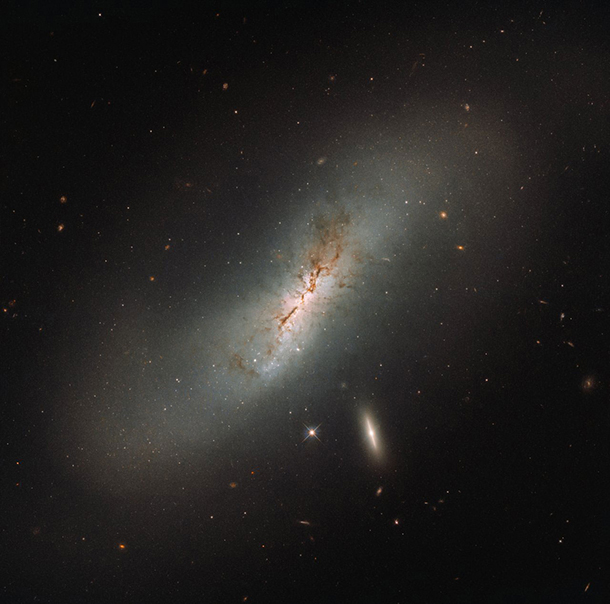
The two galaxies visible in this Hubble image are called NGC 4424 (the larger one) and LEDA 213994 (the smaller, brighter one below). Comins says the space traveler will be able to see views like this in person and may even be able to visit them in the not-so-distant future. (Photo: ESA/Hubble & NASA, Flickr CC BY 2.0)
So, what they would have women do is to have the eggs that they would want fertilized, removed, possibly even fertilized, before they leave Earth, and then put in really well protected carrying cases if you will, so that in principle when they get there and if they want to have children then -- also on Mars, I might add, the radiation is very dangerous, so they would want to gestate, to have the children living underground, for the most part, to protect those fetuses from radiation.
CURWOOD: Doesn't all that radiation though affect the testes, affect the sperm as they are being created? Male or female, if you go and get an X-ray at your doctor’s office, they put that little lead coat on you.
COMINS: You're absolutely right, and I honestly don't know if NASA has a complete set of data at this point, but it would not it would not be a good idea to fertilize an egg in space. In other words, sex, that's one thing, but fertilizing eggs in space could be damaging, because, as you said, the sperm could be damaged. However, the good news is that when the men get to a world and are protected from the radiation, say, underground on Mars, then it may be the case -- one can only hope -- it may be the case that the -- the sperm that are then generated after they have been protected from the radiation could be normal, not damaged, and then they could in principle, reproduce.
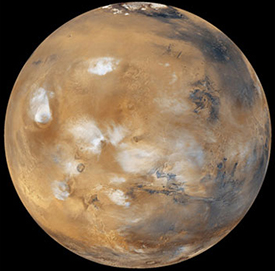
Though there are great risks involved in the colonization of Mars, Comins believes that it is inevitable and it will be the next great leap for humans. (Photo: NASA, Flickr CC BY 2.0)
CURWOOD: So, you say that there could be some really dire kinds of mistakes in space travel. What are you talking about?
COMINS: There are events that are out of people's control. Impacts happen all the time from particles in space. I'll give you an example. One atom of iron. Iron is a heavy element, but one atom is in the normal scheme of things almost undetectable here on Earth. One atom of iron traveling space at the normal speed of atoms in space... when it hits a spacecraft or a person, whatever, has the impact of a baseball thrown at a hundred miles an hour.
CURWOOD: Ouch!
COMINS: Yeah, it can ruin your whole day. Then if this one essential thing that is taken out into space to, say, put onto a spacecraft going to Mars and it floats away, then you got a serious problem. So, that's another example of the kinds of things that can happen and, in fact, do happen. And equipment fails... there's always going to be back-ups in triplicate likely, and that's going to help deal with these kinds of problems and likewise computers fail so they've got to be backed up as well.
CURWOOD: Now, somebody listening to us might say, wait a second, why go settle on Mars when we've got a perfectly good planet here as long as we keep it perfectly good.
COMINS: That's a fair question. I think that going to Mars and settling there could besides forcing us to develop the technologies to do so would enable us to have a culture, a group of people who are living together in completely different circumstances then anything on Earth, and they could potentially, in the best of all possible worlds, they could potentially provide us with an understanding of how people can interact and survive and thrive, that we could perhaps eventually use to model societies here on Earth, and I think that would be something that would be something that would be invaluable when it to comes to pass.
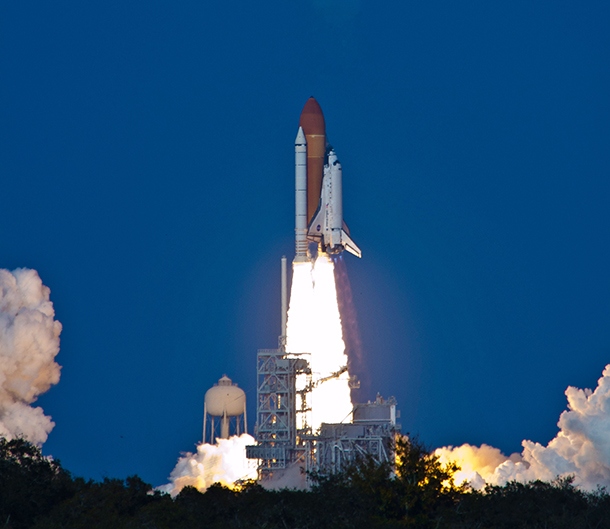
Pictured here is the Discovery shuttle’s final launch from the Kennedy Space Center in 2011. Private ventures like SpaceX and Virgin Galactic are dramatically changing and propelling forward space travel, by opening it up to citizens who are willing to pay. (Photo: NASA/Goddard/Rebecca Roth, Flickr CC BY 2.0)
CURWOOD: Neil, before you go, I wondered if you could read from your book for us. It's the beginning of chapter 10, Emigrating to Mars or Returning to Earth.
COMINS: Here we go. Colonizing Mars will create a new society of humans that is likely to identify itself as different to humans on Earth. Establishing colonies are Mars will be the hardest, most expensive, most dangerous, and most transformative emigration experience in history. Every aspect of human society will have to be modified or reinvented, including agriculture, water collection and purification, mining, manufacturing, construction, transportation, communication, medicine, reproduction, social activities, cultures, religions, education, economy, emergency responses, recreation, policing, alcohol production and protection from radiation to name a few. The first tier of needs that humans will have for survival in a long-term colony on Mars include access to safe liquid water, breathable air, food and protection from radiation from space. However, none of these things is available on the surface of the red planet today, nor will any be in the foreseeable future.
CURWOOD: So, it sounds to me like you think this will be the big leap for humanity. This will be the biggest change so far that we go through.
COMINS: That we've gone through so far, I absolutely believe that. Yes, discovering new continents was a major change, and developing technologies that we could use to make life better was a major change. But unless and until we discover life, intelligent advanced life elsewhere in our neighborhood of the universe, our going out and becoming the advanced life on another world, that's big.
CURWOOD: By the way, in your book, you don't have a handbook for what do you do if you do run into other intelligence in the universe if you're out there. Lonely Planet has a section to tell you what to deal with hassles and opportunities, but your book doesn't have anything like that.
COMINS: No, but as soon as it happens, I promise I will write that.
CURWOOD: Neil Comins' book is called "The Traveler’s Guide to Space: For One-Way Settlers and Round-Trip Tourists". Thanks so much for taking time with me today.
COMINS: My pleasure. Thank you for having me.
Related links:
- The Telegraph: “NASA announces alien life could be thriving on Saturn’s moon Enceladus”
- Space.com: “Some ‘Tatooine’ Alien Planets May Be Able to Support Life”
- Gizmodo: “SpaceX Wants You to Start Saving for Your (Possibly Deadly) Trip to Mars
- Fortune: “SpaceX and NASA Are Looking for Places to Land on Mars”
- More about Neil F. Comins
- ArsTechnica: “The Journey to Mars has a price tag, and it will give Congress sticker shock”
- Science Times: “Mars Moon Exploration Project: France & Japan Aim To Land Probe”
[MUSIC: David Buchbinder & Odessa/Havana, “Valentin” on Walk to the Sea, Tzadik Records.]
CURWOOD: Living on Earth is produced by the World Media Foundation. Our crew includes Naomi Arenberg, Bobby Bascomb, Savannah Christiansen, Jenni Doering, Noble Ingram, Jaime Kaiser, Don Lyman, Alex Metzger, Helen Palmer, Adelaide Chen, and Jolanda Omari. And we bid farewell this week to our intern, Kit Norton. Thanks, Kit, for a job well done and we wish you well! Special thanks this week to Donald Young Safaris. Tom Tiger engineered our show, with help from Jeff Wade and Jake Rego. Alison Lirish Dean composed our themes. You can find us anytime at LOE.org - and like us, please, on our Facebook page - it’s PRI’s Living on Earth. And we tweet from @LivingonEarth. I'm Steve Curwood. Thanks for listening.
ANNOUNCER1: Funding for Living on Earth comes you, our listeners, and from the University of Massachusetts, Boston, in association with its School for the Environment, developing the next generation of environmental leaders. And from the Grantham Foundation for the protection of the environment, supporting strategic communications and collaboration in solving the world’s most pressing environmental problems. Support also comes from the Energy Foundation, serving the public interest by helping to build a strong, clean, energy economy, from Carl and Judy Ferenbach of Boston, Massachusetts and from SolarCity, America’s solar power provider. SolarCity is dedicated to revolutionizing the way energy is delivered by giving customers a renewable alternative to fossil fuels. Information at 888-997-1703. That’s 888-997-1703.
ANNOUNCER2: PRI. Public Radio International.
Living on Earth wants to hear from you!
Living on Earth
62 Calef Highway, Suite 212
Lee, NH 03861
Telephone: 617-287-4121
E-mail: comments@loe.org
Newsletter [Click here]
Donate to Living on Earth!
Living on Earth is an independent media program and relies entirely on contributions from listeners and institutions supporting public service. Please donate now to preserve an independent environmental voice.
NewsletterLiving on Earth offers a weekly delivery of the show's rundown to your mailbox. Sign up for our newsletter today!
 Sailors For The Sea: Be the change you want to sea.
Sailors For The Sea: Be the change you want to sea.
 The Grantham Foundation for the Protection of the Environment: Committed to protecting and improving the health of the global environment.
The Grantham Foundation for the Protection of the Environment: Committed to protecting and improving the health of the global environment.
 Contribute to Living on Earth and receive, as our gift to you, an archival print of one of Mark Seth Lender's extraordinary wildlife photographs. Follow the link to see Mark's current collection of photographs.
Contribute to Living on Earth and receive, as our gift to you, an archival print of one of Mark Seth Lender's extraordinary wildlife photographs. Follow the link to see Mark's current collection of photographs.
 Buy a signed copy of Mark Seth Lender's book Smeagull the Seagull & support Living on Earth
Buy a signed copy of Mark Seth Lender's book Smeagull the Seagull & support Living on Earth

